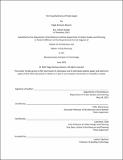| dc.contributor.advisor | Mazereeuw, Miho | |
| dc.contributor.advisor | Vale, Lawrence J. | |
| dc.contributor.author | Alvarez, Paige Xiomara | |
| dc.date.accessioned | 2022-02-15T17:01:51Z | |
| dc.date.available | 2022-02-15T17:01:51Z | |
| dc.date.issued | 2021-06 | |
| dc.date.submitted | 2021-07-27T20:27:00.687Z | |
| dc.identifier.uri | https://hdl.handle.net/1721.1/140358 | |
| dc.description.abstract | Domestic life - the programs and functions most closely associated with housing and home - has been largely programmed out of the public spaces of cities in order to make them inhospitable to unhoused residents and the urban poor more broadly. Most visible in the form of so-called hostile architecture, these anti-domestic practices result in public spaces that discourage lingering or gathering, in which it is difficult to spend time. This thesis takes up the role of architects and urban designers in houselessness, not through our positions on affordable housing, but by considering the ways that we play a part in perpetuating the privatization of domesticity. In doing so, we center a long-lasting definition of the socio-political project of “the public'' which defines membership through one’s proximity and access to property. Public spaces of the city are then further policed to discourage uses and occupations that are discordant with the recreational, ordered dominant use case.
Despite this, the public spaces of cities are made house-full by unhoused residents. Lacking access to the programs packaged in housing, unhoused residents piece together different rooms and play out different routines of necessity and joy throughout the city. Attempts to design unhoused people out of public space have resulted in a universally hostile public realm whose impacts are unevenly felt. Unhoused people are closest to this problem and bear the brunt of its violence. In this thesis I consider what public space begins to look like when those of us that design it critically change our agenda. What could the public realm look like if we expanded its domestic possibilities rather than restricting them, and how can we center the domesticities of unhoused residents in that expansion? What happens when public space is seen as housefull? | |
| dc.publisher | Massachusetts Institute of Technology | |
| dc.rights | In Copyright - Educational Use Permitted | |
| dc.rights | Copyright retained by author(s) | |
| dc.rights.uri | https://rightsstatements.org/page/InC-EDU/1.0/ | |
| dc.title | The Houseful(l)ness of Public Space | |
| dc.type | Thesis | |
| dc.description.degree | M.Arch. | |
| dc.description.degree | M.C.P. | |
| dc.contributor.department | Massachusetts Institute of Technology. Department of Architecture | |
| dc.contributor.department | Massachusetts Institute of Technology. Department of Urban Studies and Planning | |
| mit.thesis.degree | Master | |
| thesis.degree.name | Master of Architecture | |
| thesis.degree.name | Master in City Planning | |

